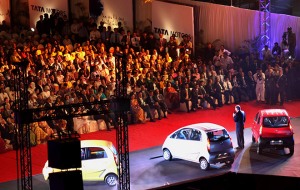A $2,000 car? The Chairman of Suzuki Motor Corporation said it was impossible…but, that didn’t deter Ratan Tata. Motivated by a passion for meeting the needs of India’s impoverished people, the Chairman of Tata Motors assembled a five person engineering team (with an average age of 27) and launched a four year journey which began with an audacious goal and ended with a paradigm shift in the auto industry.
Rather than begin with a set of design criteria for the team to use when approaching the problem, Tata gave them an impossible goal: build a car for $2,000. In fact, the cost target was the only fixed point with which the team was forced to work. In every other aspect of the project, the team was challenged to “question the unquestionable” and utilize an open innovation model which considered ideas from anywhere and everywhere.
The audaciousness of the goal combined with the freedom to “break the rules” led to many industry leading innovations. The Nano is the first time a 2 cylinder gas engine has been used in a car with a single balancer shaft. Adhesives have replaced all rivets and mechanisms from a helicopter were used when designing the seats and windows. The car’s 9 foot frame is 8% shorter than other compact cars, while providing the passengers 21% more interior room. In addition, each part in the car serves a dual function, resulting in 1/2 the total number of parts as a normal car. Finally, the team also had to think about its supply chain differently. The Nano was designed in partnership with Tato’s vendors and suppliers, 100 vendors were co-located adjacent to the plant and the company developed a new business model for dealerships which slashed distribution costs.
The development of the Tata Nano is one of many examples of leaders inspiring teams to achieve seemingly impossible goals in the midst of tight deadlines. As with each of these game changing innovations, it was Tata’s unwavering commitment to an impossible goal combined with a freedom to experiment by the engineering team which caused a shift in the paradigm. All to often however, leaders take an opposite approach when trying to drive innovation. The goals set are far too safe to force a new way of thinking and rather then giving teams latitude to experiment, they script their actions through detailed charters, procedures and return on investment criteria. The combination of weak goals and stifling process boundaries kills creativity and ensures mediocrity.
If you want to experience the power of a inspired team who believes there is nothing they can’t accomplish, set an impossible goal and give your people the autonomy to discover radically new solutions to some of your toughest challenges.
“Impossible is nothing.” – Adidas




I always find your entries interesting and I learn so much from reading them.
Please keep writing because those of us who are not “in your field” can learn so much.
Thanks for continuing to read the blog and comment on it. Many of the principles discussed in the blog posts began as a lesson learned at Pacific Rim.
Just as the Swedish and probably many other cultures have unique vocabulary to describe certain concepts, in India, jugaad is one such word. HBR defines it as, “overcoming harsh constraints by improvising an effective solution using limited resources” (http://blogs.hbr.org/cs/2010/01/jugaad_a_new_growth_formula_fo.html). It’s pretty amazing what they’ve done. Thank you for posting this.
I saw this post from LinkedIn.
Thanks for the comment…I had not heard the word before, but am very familiar with the concept. I used to turnaround companies and we were always required to “overcome harsh constraints by improvising an effective solution using limited resources.” Thanks for including the link to the blog post. I will check it out.